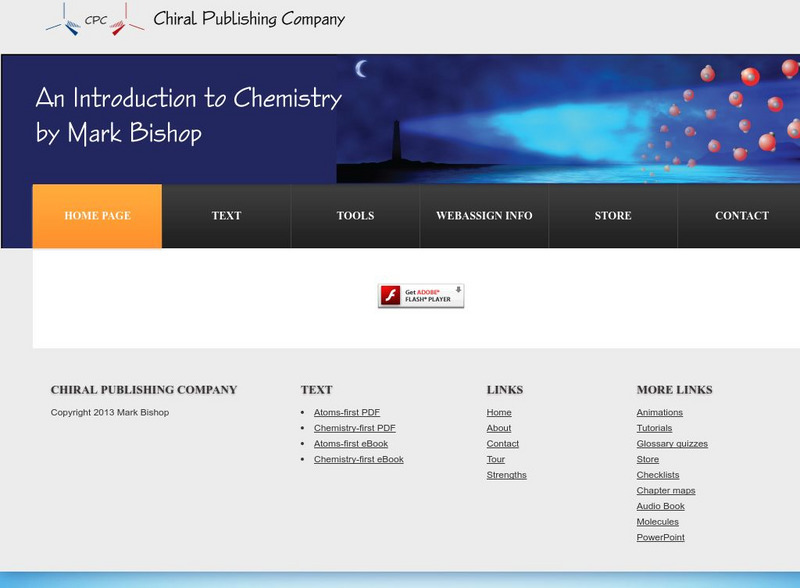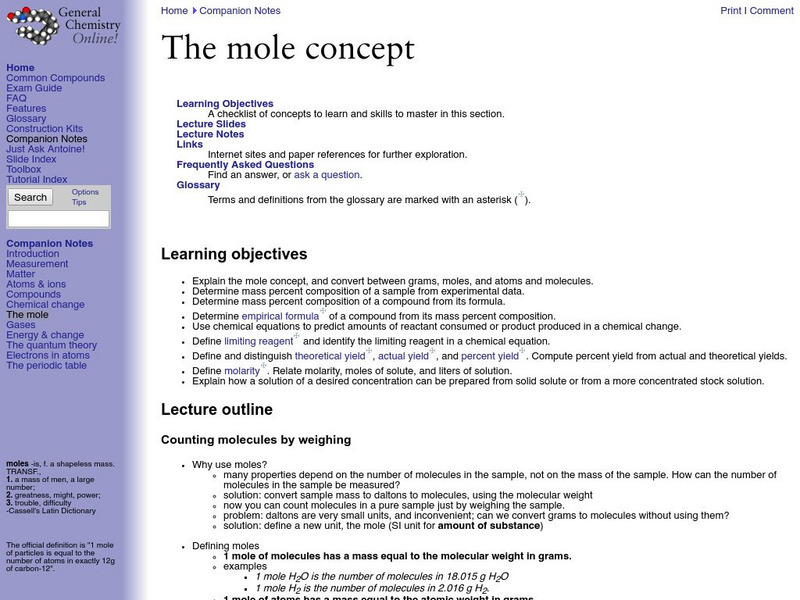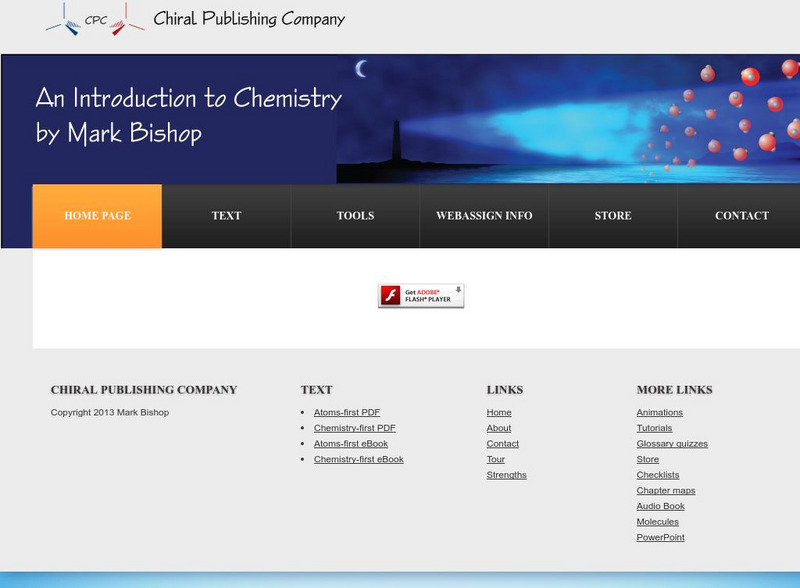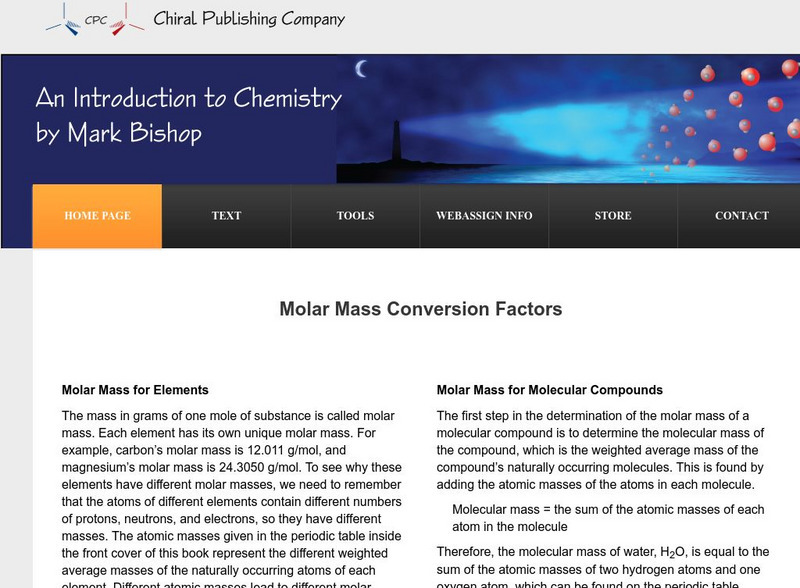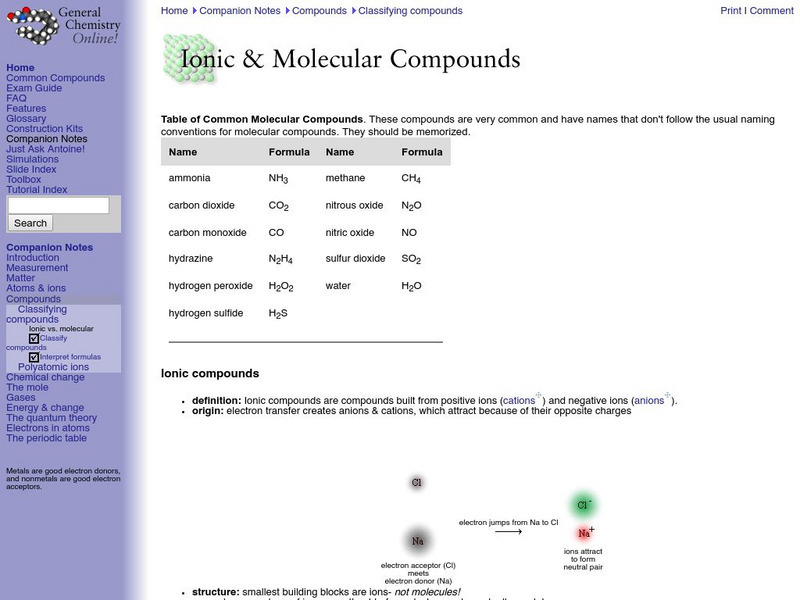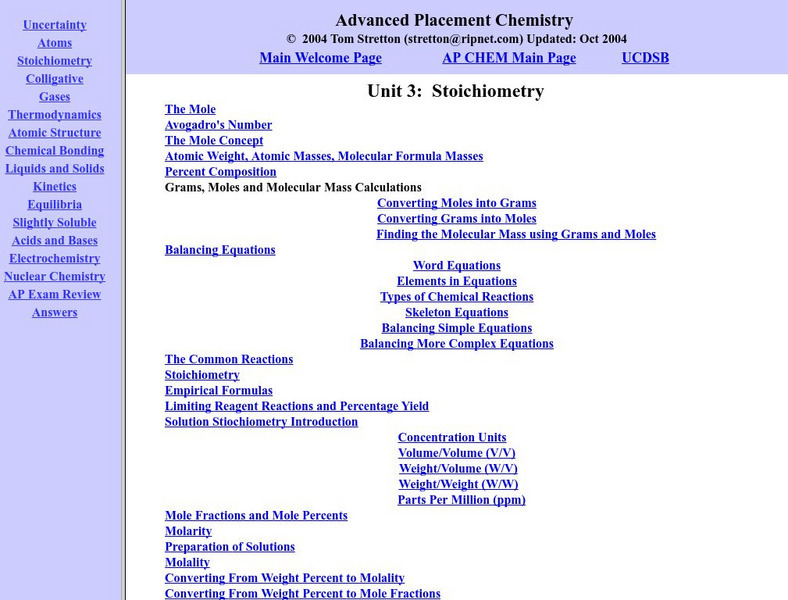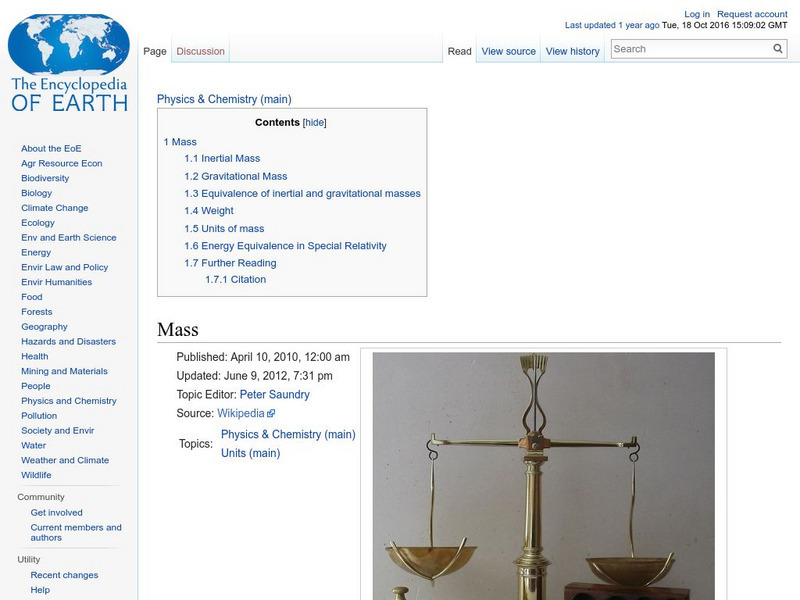Chiral Publishing
Chiral Publishing: An Introduction to Chemistry: Ionic Nomenclature
Test yourself on ionic nomenclature. Convert either names to formulas or formulas to names. After this quiz, you'll remember how to name cations and anions.
American Chemical Society
Middle School Chemistry: What Is a Chemical Reaction?
Use chemical formulas to visualize how chemical equations are balanced.
Chiral Publishing
Chiral Publishing: An Introduction to Chemistry: Important Substances in Food: Audio Book
Learn about the chemical compounds in the foods that you eat everyday. By viewing this audio book, you'll see many structural formulas of these compounds. Also find links to other chapters in the online textbook, animations, and power...
Frostburg State University
General Chemistry Online: Faq the Mole Concept
This FAQ site over general chemistry concepts presents the question: "Why are moles used?" It explains what moles are and how they can be used to count molecules and how grams can be turned into moles.
Science Education Resource Center at Carleton College
Serc:let's Do Some Bonding! Writing Balanced Formulas and Naming Ionic Compounds
Let's do some bonding! In this activity, students gain practice balancing ionic formulas and naming ionic compounds. They also have the opportunity to meet and 'bond with' students and staff outside the chemistry classroom.
Chem Tutor
Chem Tutor: Chemistry: Writing Ionic Compound Formulas
A tutorial on writing formulas for ionic compounds.
Chiral Publishing
Chiral Publishing: An Introduction to Chemistry: Synthetic Polymers: Audio Book
This short audio book describes some common synthetic polymers and their chemical formulas. Find links for animations, tutorials, and power points on many other chemistry topics.
Frostburg State University
General Chemistry Online: Simple Compounds Faq
Studying simple compounds in chemistry? Find answers to several commonly asked questions with topics ranging from compound classification to polyatomic ions.
Chiral Publishing
Chiral Publishing: An Introduction to Chemistry: Acids and Bases
See how much you know about acids and bases through this fun tutorial. Practice matching the names or formulas to the correct category of acids or bases.
Chiral Publishing
Chiral Publishing: An Introduction to Chemistry: Types of Substances
Practice classifying substances using this fun, interactive exercise. Get either the formulas or names of substances, and decide which type of compound it is.
Chiral Publishing
Chiral Publishing: An Introduction to Chemistry: Molecular Structures: Acids
Vview molecular structures and formulae of four common acids - acetic, nitric, phosphoric, and carbonic. Manipulate each structure to view it in a three-dimensional format.
Chiral Publishing
Chiral Publishing: An Introduction to Chemistry: Molar Mass Conversion Factors
Read how to use molar mass equations to find conversion factors and molecular compounds. View several examples using given formulas for molar mass.
Chiral Publishing
Chiral Publishing: An Introduction to Chemistry: Relating Mass to Number of Particles: Audio Book
This slide and audio book shows how to relate mass to a number of particles by using many formulas, examples, and real life scenarios. View the weighted average calculations, Avogadro's number, the atomic mass of carbon, and molar mass.
Upper Canada District School Board
Tom Stretton's Advanced Placement Chemistry: Atoms, Molecules and Ions
This online textbook chapter provides learners with advanced-level material on the structure and relationships between atoms, molecules and ions.
Frostburg State University
General Chemistry Online: Ionic and Molecular Compounds
Provides a good outline of the concepts involved in ionic and covalent bonding, with links to definition of terms. Features a list of common molecular compounds and a chart that compares ionic and molecular compounds.
Upper Canada District School Board
Tom Stretton's Advanced Placement Chemistry: Stoichiometry
This online textbook chapter provides learners with advanced-level reading and practice material on stoichiometry
Encyclopedia of Earth
Encyclopedia of Earth: Physics & Chemistry: Mass
Defines inertial and gravitational mass, their scientific history, formulas used in their calculation, the definition of weight, units used for mass, and mass as perceived in the theory of special relativity.
Frostburg State University
Frostburg State University Chemistry Online: Polyatomic Ions
A good reference page for anyone studying polyatomic ions. Tables included on this page organize polyatomic ions by family and by charge. Information on naming compounds with polyatomic ions is also provided. There is a link to an online...
Other
Organic Chemistry: Lewis/kekule Structures
This slide presentation contains a few slides that will be useful for students learning to write Lewis structures. A discussion of multiple bonds is included, and clear examples are shown.
Frostburg State University
General Chemistry Online: The Mole Concept
Resource provides notes on Moles and Stoichiometry. Deals with all book-keeping aspects, including as section on yields and limiting reactants. Includes lesson plans, lecture slides and notes, links to related websites, and frequently...
University of California
Organic Chemistry Page: A Brief Tutorial on Drawing Lewis Dot Structures
An excellent lesson on writing Lewis structures. Examples shown include ammonium ion, carbon dioxide and the carbonate ion.
CK-12 Foundation
Ck 12: Chemistry: Naming Acids
[Free Registration/Login may be required to access all resource tools.] Defines acid, naming of acids, and writing formulas for acids.
Chem Tutor
Chem Tutor: Chemistry: Compounds
This lesson focuses on chemical compounds including Ionic and Covalent Bonds, Valences, Lewis Structures, Binary Covalent Compounds, Radicals or Polyatomic Ions, and much more. It also includes a compound worksheet in which the learners...
ClassFlow
Class Flow: Compound Nomenclature and Formulas
[Free Registration/Login Required] This flipchart provides an introduction to naming and writing formulas for compounds and includes assessment questions.
